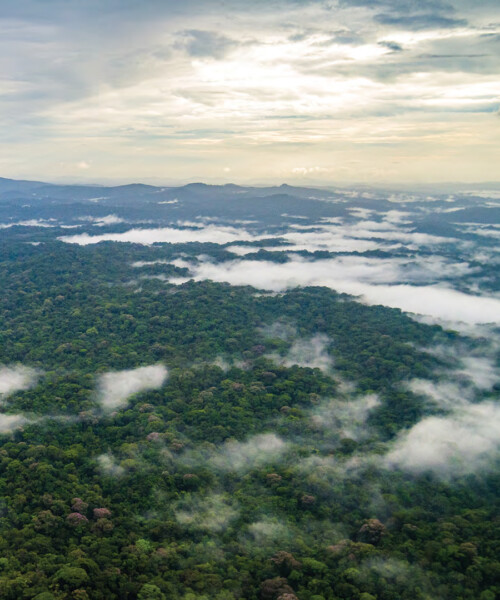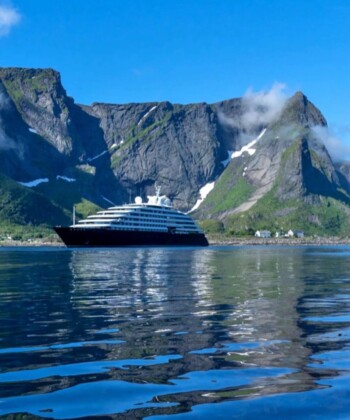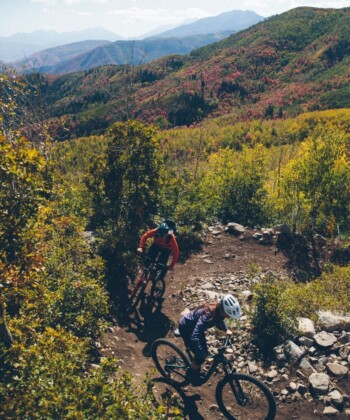The 25th United Nations Climate Change Conference (COP25), held in Madrid this past December, was not the galvanizing call to action its organizers hoped for. Despite the gleaming spotlight on such events as the appearance of 16-year-old Swedish activist Greta Thunberg, whose riveting, urgent speech at the U.N. Climate Action Summit in New York in September still rang in collective ears, the results of COP25 came up frighteningly short. Longtime participant Alden Meyer, director of strategy and policy for the Union of Concerned Scientists, summed up widely shared concern, saying: “Never have I seen the almost total disconnect between what the science requires and what the climate negotiations are delivering in terms of meaningful action… Most of the world’s biggest emitting countries are missing in action and resisting calls to raise their ambition.”

A map indicating Mesoamerica’s five great forests.
Fortunately, far better news emerged from eight countries of Central America, which presented their regional climate action plan, committing to protect Mesoamerica’s five great forests as part of the natural solution to the climate crisis. This ambitious enterprise aims to bring together the agricultural and environmental sectors to restore and conserve 10 million hectares of forests and degraded land by 2030, and achieve carbon neutrality in the agricultural and forest sector by 2040.
The 5 Great Forests of Mesoamerica is an initiative of Forests for Life, a partnership announced in September that is composed of local and international NGOs—including Global Wildlife Conservation (GWC) and Wildlife Conservation Society (WCS)—the eight countries of the Central American Commission for Environment and Development (CCAD) (Belize, Guatemala, Costa Rica, Honduras, El Salvador, Nicaragua, Panama, and the Dominican Republic), and indigenous peoples and local communities, including the Mesoamerican Alliance for People and Forests (AMPB), all commit-ting to work together to protect Mesoamerica’s five great forests. The alliance highlighted the critical leadership role of indigenous peoples and local communities in forest conservation and announced governmental climate commitments by ministries of environment from Belize, Costa Rica, El Salvador, Guatemala, Honduras, Nicaragua, and Panama.

Deforestation in Nicaragua’s Indio Maíz Biological Reserve.
“This is a unique opportunity for Central America in which governments, indigenous leaders, and civil society are coalescing around shared objectives and a shared strategy,” says Chris Jordan, GWC’s Central America and tropical Andes coordinator. “Mesoamerica has massive potential to empower indigenous peoples and local communities, to continue to title indigenous territories, stop the deforestation of these critical forests, and harmonize policies and incentive programs to ensure their protection in perpetuity. We encourage others to join this important initiative.”
The five great forests include Maya Forest in Mexico, Guatemala, and Belize; the Moskitia in Nicaragua and Honduras; the Indio Maíz-Tortuguero in Nicaragua and Costa Rica; the Talamanca Region in Costa Rica and Panama; and the Darien in Panama and Colombia.

Cattle ranching and forest destruction.
These forests not only hold a majority of the region’s forest carbon stocks, helping to curb climate change, but also are critical to both wildlife and people. They are biodiversity hot spots and strongholds for globally irreplaceable species, such as the jaguar, scarlet macaw, and critically endangered Central American river turtle. They provide vital flyways and wintering grounds for migratory birds, as well as water, clean air, food security, and other vital natural resources to 5 million people. Indigenous and local communities manage nearly half of the area encompassed by the forests.

The scarlet macaw.
“Nearly 50 percent of the carbon in Mesoamerica is stored in the five great forests,” says Carlos Manuel Rodríguez, minister of environment for Costa Rica and a champion of the 5 Great Forests Initiative. “I hope that I won’t be back here in the future talking about the 10 medium-sized forests.”
Rodríguez is referring to the fact that up to now, the five forests have been under siege: In the last 15 years, three of them have been reduced by almost a quarter in size, with illegal cattle ranching responsible for more than 90 percent of recent deforestation.

Indigenous Rama children at their home along the Indian River in Nicaragua.
“We are sad to see the forests of the Amazon burning and the impacts on indigenous people,” says Cándido Mezúa, an executive board member of the Mesoamerican Alliance of Peoples and Forests. “In Mesoamerica, we have our five forests. They still exist. We can still protect them, and even expand them.”
To definitively turn the tide, the new alliance aims to ensure that: no wildlife species in the great forests go extinct; 10 million hectares of land are protected; 500,000 hectares of forest are restored; livelihoods are improved, especially for indigenous and local communities within the five forests; and illegal cattle ranching within the boundaries of the five forests ceases entirely. “The 5 Great Forests initiative is not a project, but a movement,” says Jeremy Radachowsky, WCS director of the Mesoamerica and Western Caribbean region. “We’ve been honored to join with government and indigenous partners at the COP25, but the hard work lies ahead. We must come together to protect Mesoamerica’s five great forests, and we invite anyone who can help to support this critical initiative.”
To mark this important commitment and celebrate the majesty of Mesoamerica’s forests, the alliance held a weeklong social media campaign in December around the five great forests, inviting everyone to join the movement. Yet even as responses rolled in, the scale of the devastating wildfires in Australia became clear, reminding everyone that yes, the hardest and most important work lies ahead. If GWC and its global partners prevail, that work can begin without a single moment wasted.







































